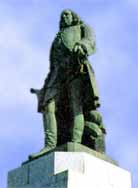|
|

|
|

| ||
 The
statue is Pondicherry's tribute to Francois Dupleix whose able governorship came to an end in 1754. The
statue is Pondicherry's tribute to Francois Dupleix whose able governorship came to an end in 1754.
However, French recognition came about a century later, when, in 1870, they paid homage by commissioning two statues-one in France and the other in Pondicherry. The 2.88 m tall structure was erected over six carved ornamental granite pillars at the Place du Republique. It now stands restationed overlooking a children's park at the southern end of a promenade, now named Goubert Avenue. Place Du Gouvernement At the centre, surrounded by a well-tended garden, stands the Water Monument, sculpted to commemorate the introduction of good drinking water for the population. Some exquisitely carved monolithic pillars, brought to Pondicherry from the Gingee Fort after its capture in 1751, adorn the place.
19th Century Lighthouse French War Memorial The Statue of Joan of Arc Sri Aurobindo Ashram Madame Mirra Alfassa, a French painter-sculptor who had followed the same path on her own, joined him later. She is now known as the Mother. Together, in 1926, they founded an ashram at rue de la Marine where his belief -"All life is Yoga"- was put into practice. Followers from India and all over the world flock to Sri Aurobindo Ashram for spiritual salvation. At night time, Pondicherrians who believe in Sri Aurobindo's way of life, wind their way ashram ward. Inside, the lights throw a welcome radiance. Over it all, the flower-decked samadhi of the mortal remains of Aurobindo and the Mother presides. Men and women meditate with their eyes fixed on the marble samadhi. Here silence is peace, and flowers and incense are ways to lead the mind away from work day shackles. By day, the ashram bustles with silent queues to visit the rooms used by Sri Aurobindo and the mother for meditation or blessings. Birth Anniversary of the Mother and Sri Aurobindo is celebrated on 21st February and 15th august respectively. Click for more information Timings : Open from 8 am -12 pm and 2 pm-6 pm. Children below 3 years of age are not allowed. Ariyankuppam ( Arikamedu) Moreover, you will find the amazing ruins of an 18th century French Jesuit Mission House here. It was abandoned in 1783. Park Monument (Aayi Mandapam) It bears the name of Aayi- a 16th century courtesan, who razed down her home and replaced it with a reservoir. To appease a passing king, angry at having mistaken her candle-lit residence for a holy place. It was from this lake that Napoleon's men quenched their thirst, some 300 years later. Napoleon, charmed by the story, ordered a monument to Aayi. Ananda Ranga Pillai Mansion It is one of the oldest surviving buildings on the west side - then known as "natives quarters." Its architecture represents a curious mix of French and Indian styles. The French Cemetery at Karaikal |